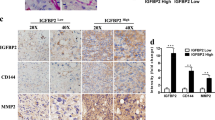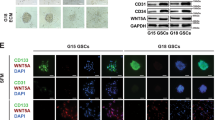Abstract
Leucine-rich repeats and immunoglobulin-like domains 1 (LRIG1) is a pan-negative regulator of the epidermal growth factor receptor (EGFR) signaling pathway. The aim of this study was to investigate the underlying mechanism of LRIG1 in the regulation of vasculogenic mimicry (VM) formation in glioma cells. We constructed an enhanced green fluorescent protein plasmid (pEGFP) system, pEGFP-C1-LRIG1, for overexpression of LRIG1, and transfected it into human glioma cell line SHG-44. Under hypoxic conditions induced by CoCl2, we investigated the effects of LRIG1 overexpression on VM formation and VM-dependent malignant behaviors including migration, invasion, and proliferation. Additionally, we explored the effects of LRIG1 on the expression levels of major components of the EGFR/PI3K/AKT pathway as well as E-cadherin and vimentin. We found that LRIG1 overexpression is able to inhibit hypoxia-induced VM formation, migration, invasion, and proliferation. Furthermore, LRIG1 overexpression counteracts hypoxia-induced increase in the expression of phosphorylated EGFR (pEGFR), PI3K (pPI3K), and AKT (pAKT) and reverts hypoxia-induced alteration in E-cadherin and vimentin expression levels. In LRIG1 knockdown SHG-44 cells, however, hypoxia-induced VM formation and alteration in E-cadherin and vimentin expression levels were exacerbated. These results suggest that the inhibitory effects of LRIG1 are most likely mediated by suppression of the EGFR/PI3K/AKT pathway and epithelial-mesenchymal transition (EMT) process. Our findings provide compelling evidence implicating LRIG1 in glioma pathophysiology, suggesting that gene therapy using LRIG1 may serve as a treatment for this disease.









Similar content being viewed by others
References
Du J, Sun B, Zhao X et al (2014) Hypoxia promotes vasculogenic mimicry formation by inducing epithelial-mesenchymal transition in ovarian carcinoma. Gynecol Oncol 133(3):575–583
Fan YZ, Sun W (2010) Molecular regulation of vasculogenic mimicry in tumors and potential tumor-target therapy. World J Gastrointest Surg 2(4):117–127
Gotoh N (2009) Feedback inhibitors of the epidermal growth factor receptor signaling pathways. Int J Biochem Cell Biol 41(3):511–515
Guo D, Nilsson J, Haapasalo H et al (2006) Perinuclear leucine-rich repeats and immunoglobulin-like domain proteins (LRIG1-3) as prognostic indicators in astrocytic tumors. Acta Neuropathol 111(3):238–246
Holmlund C, Haapasalo H, Yi W et al (2009) Cytoplasmic LRIG2 expression is associated with poor oligodendroglioma patient survival. Neuropathology 29(3):242–247
Huang M, Ke Y, Sun X et al (2014) Mammalian target of rapamycin signaling is involved in the vasculogenic mimicry of glioma via hypoxia-inducible factor-1alpha. Oncol Rep 32(5):1973–1980
Johansson M, Oudin A, Tiemann K et al (2013) The soluble form of the tumor suppressor Lrig1 potently inhibits in vivo glioma growth irrespective of EGF receptor status. Neuro Oncol 15(9):1200–1211
Kumar M, Nagpal R, Hemalatha R et al (2012) Targeted cancer therapies: the future of cancer treatment. Acta Biomed 83(3):220–233
Maniotis AJ, Folberg R, Hess A et al (1999) Vascular channel formation by human melanoma cells in vivo and in vitro: vasculogenic mimicry. Am J Pathol 155(3):739–752
Misra RM, Bajaj MS, Kale VP (2012) Vasculogenic mimicry of HT1080 tumour cells in vivo: critical role of HIF-1alpha-neuropilin-1 axis. PLoS One 7(11):e50153
Mongiardi MP (2012) Angiogenesis and hypoxia in glioblastoma: a focus on cancer stem cells. CNS Neurol Disord Drug Targets 11(7):878–883
Omuro A, DeAngelis LM (2013) Glioblastoma and other malignant gliomas: a clinical review. JAMA 310(17):1842–1850
Paulis YW, Soetekouw PM, Verheul HM, Tjan-Heijnen VC, Griffioen AW (2010) Signalling pathways in vasculogenic mimicry. Biochim Biophys Acta 1806(1):18–28
Persano L, Rampazzo E, Basso G, Viola G (2013) Glioblastoma cancer stem cells: role of the microenvironment and therapeutic targeting. Biochem Pharmacol 85(5):612–622
Plate KH, Scholz A, Dumont DJ (2012) Tumor angiogenesis and anti-angiogenic therapy in malignant gliomas revisited. Acta Neuropathol 124(6):763–775
Seftor RE, Hess AR, Seftor EA et al (2012) Tumor cell vasculogenic mimicry: from controversy to therapeutic promise. Am J Pathol 181(4):1115–1125
Taylor TE, Furnari FB, Cavenee WK (2012) Targeting EGFR for treatment of glioblastoma: molecular basis to overcome resistance. Curr Cancer Drug Targets 12(3):197–209
Van Meir EG, Hadjipanayis CG, Norden AD, Shu HK, Wen PY, Olson JJ (2010) Exciting new advances in neuro-oncology: the avenue to a cure for malignant glioma. CA Cancer J Clin 60(3):166–193
Verhaak RG, Hoadley KA, Purdom E et al (2010) Integrated genomic analysis identifies clinically relevant subtypes of glioblastoma characterized by abnormalities in PDGFRA, IDH1, EGFR, and NF1. Cancer Cell 17(1):98–110
Wang SY, Yu L, Ling GQ et al (2012) Vasculogenic mimicry and its clinical significance in medulloblastoma. Cancer Biol Ther 13(5):341–348
Wang SY, Ke YQ, Lu GH et al (2013) Vasculogenic mimicry is a prognostic factor for postoperative survival in patients with glioblastoma. J Neurooncol 112(3):339–345
Wang W, Lin P, Sun B et al (2014) Epithelial-mesenchymal transition regulated by EphA2 contributes to vasculogenic mimicry formation of head and neck squamous cell carcinoma. Biomed Res Int 2014:803914
Xie R, Yang H, Xiao Q et al (2013) Downregulation of LRIG1 expression by RNA interference promotes the aggressive properties of glioma cells via EGFR/Akt/c-Myc activation. Oncol Rep 29(1):177–184
Xu G, Bai X, Wang M, Xie W, Li R, Li C (2013a) Characterization of glycolytic phenotype of SHG44 human glioma cells under hypoxic conditions and its association with cell proliferation and apoptosis. Nan Fang Yi Ke Da Xue Xue Bao 33(3):406–411
Xu P, Zhang A, Jiang R et al (2013b) The different role of Notch1 and Notch2 in astrocytic gliomas. PLoS One 8(1):e53654
Ye F, Gao Q, Cai MJ (2010) Therapeutic targeting of EGFR in malignant gliomas. Expert Opin Ther Targets 14(3):303–316
Zhang S, Zhang D, Sun B (2007) Vasculogenic mimicry: current status and future prospects. Cancer Lett 254(2):157–164
Zhou X, Hu Y, Dai L et al (2014) MicroRNA-7 inhibits tumor metastasis and reverses epithelial-mesenchymal transition through AKT/ERK1/2 inactivation by targeting EGFR in epithelial ovarian cancer. PLoS One 9(5):e96718
Zuo JH, Zhu W, Li MY et al (2011) Activation of EGFR promotes squamous carcinoma SCC10A cell migration and invasion via inducing EMT-like phenotype change and MMP-9-mediated degradation of E-cadherin. J Cell Biochem 112(9):2508–2517
Conflict of interest
The authors report no conflicts of interest.
Author information
Authors and Affiliations
Corresponding author
Rights and permissions
About this article
Cite this article
Zhang, X., Song, Q., Wei, C. et al. LRIG1 inhibits hypoxia-induced vasculogenic mimicry formation via suppression of the EGFR/PI3K/AKT pathway and epithelial-to-mesenchymal transition in human glioma SHG-44 cells. Cell Stress and Chaperones 20, 631–641 (2015). https://doi.org/10.1007/s12192-015-0587-y
Received:
Revised:
Accepted:
Published:
Issue Date:
DOI: https://doi.org/10.1007/s12192-015-0587-y




